Financial Accounting Assignment: Analysis and Calculations
VerifiedAdded on 2022/11/24
|27
|4597
|451
Homework Assignment
AI Summary
This document presents a comprehensive solution to a financial accounting assignment, addressing key concepts and practical applications. The assignment includes detailed explanations of different types of business transactions (cash and credit), bookkeeping systems (single and double-entry), and the importance of trial balances. It also features calculations and journal entries, alongside the differences between financial statements and financial reports. Furthermore, the assignment covers accounting principles (conservatism, consistency, cost, etc.), profit and loss accounts, cash flow statements, bank reconciliations, control accounts, and suspense accounts. The solution provides step-by-step calculations, comparative analyses, and theoretical explanations, making it a valuable resource for students studying financial accounting. The document is a student contribution to Desklib, a platform offering AI-based study tools.

Financial Accounting
Paraphrase This Document
Need a fresh take? Get an instant paraphrase of this document with our AI Paraphraser

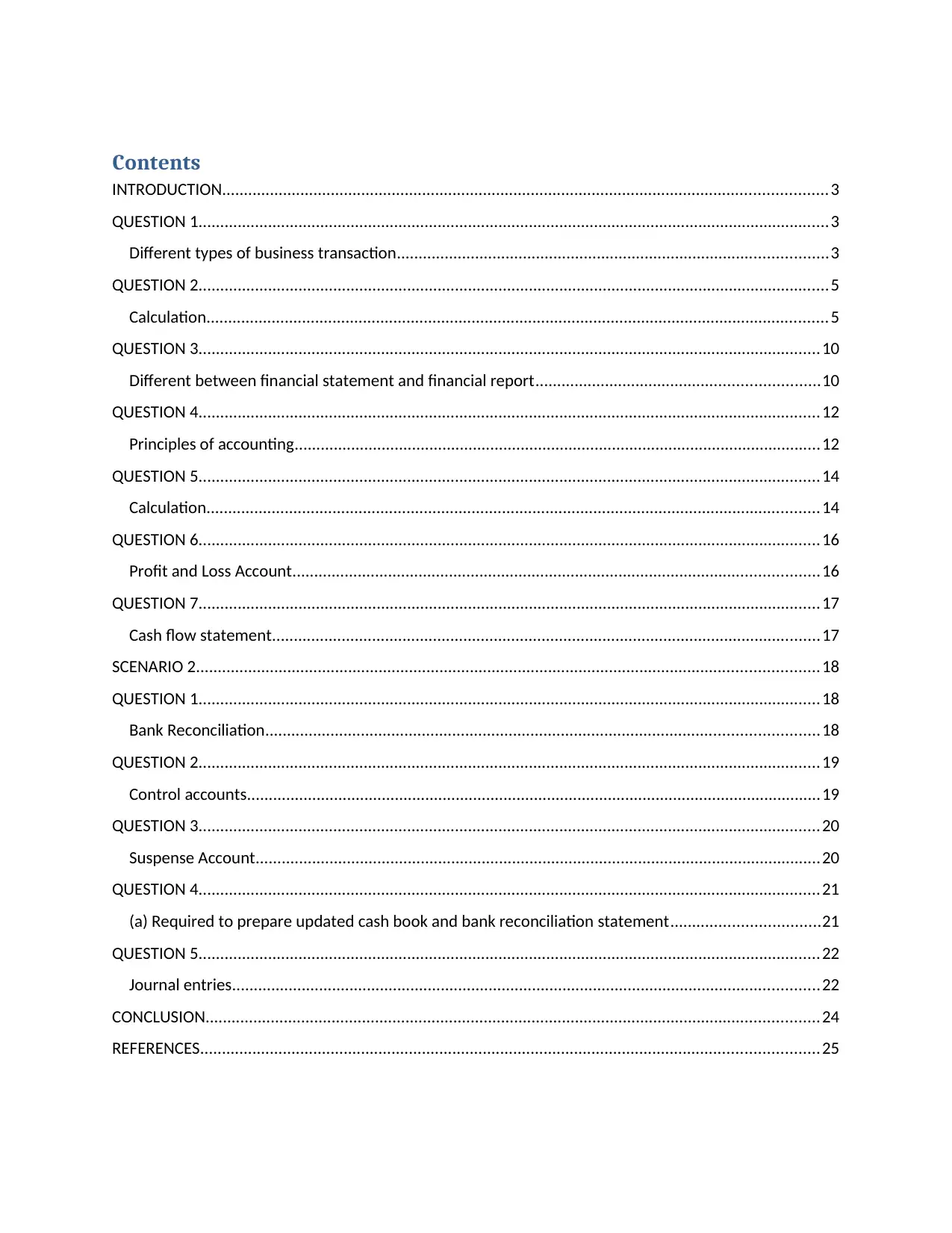
Contents
INTRODUCTION...........................................................................................................................................3
QUESTION 1.................................................................................................................................................3
Different types of business transaction...................................................................................................3
QUESTION 2.................................................................................................................................................5
Calculation...............................................................................................................................................5
QUESTION 3...............................................................................................................................................10
Different between financial statement and financial report.................................................................10
QUESTION 4...............................................................................................................................................12
Principles of accounting.........................................................................................................................12
QUESTION 5...............................................................................................................................................14
Calculation.............................................................................................................................................14
QUESTION 6...............................................................................................................................................16
Profit and Loss Account.........................................................................................................................16
QUESTION 7...............................................................................................................................................17
Cash flow statement..............................................................................................................................17
SCENARIO 2...............................................................................................................................................18
QUESTION 1...............................................................................................................................................18
Bank Reconciliation...............................................................................................................................18
QUESTION 2...............................................................................................................................................19
Control accounts....................................................................................................................................19
QUESTION 3...............................................................................................................................................20
Suspense Account..................................................................................................................................20
QUESTION 4...............................................................................................................................................21
(a) Required to prepare updated cash book and bank reconciliation statement..................................21
QUESTION 5...............................................................................................................................................22
Journal entries.......................................................................................................................................22
CONCLUSION.............................................................................................................................................24
REFERENCES..............................................................................................................................................25
INTRODUCTION...........................................................................................................................................3
QUESTION 1.................................................................................................................................................3
Different types of business transaction...................................................................................................3
QUESTION 2.................................................................................................................................................5
Calculation...............................................................................................................................................5
QUESTION 3...............................................................................................................................................10
Different between financial statement and financial report.................................................................10
QUESTION 4...............................................................................................................................................12
Principles of accounting.........................................................................................................................12
QUESTION 5...............................................................................................................................................14
Calculation.............................................................................................................................................14
QUESTION 6...............................................................................................................................................16
Profit and Loss Account.........................................................................................................................16
QUESTION 7...............................................................................................................................................17
Cash flow statement..............................................................................................................................17
SCENARIO 2...............................................................................................................................................18
QUESTION 1...............................................................................................................................................18
Bank Reconciliation...............................................................................................................................18
QUESTION 2...............................................................................................................................................19
Control accounts....................................................................................................................................19
QUESTION 3...............................................................................................................................................20
Suspense Account..................................................................................................................................20
QUESTION 4...............................................................................................................................................21
(a) Required to prepare updated cash book and bank reconciliation statement..................................21
QUESTION 5...............................................................................................................................................22
Journal entries.......................................................................................................................................22
CONCLUSION.............................................................................................................................................24
REFERENCES..............................................................................................................................................25
⊘ This is a preview!⊘
Do you want full access?
Subscribe today to unlock all pages.

Trusted by 1+ million students worldwide
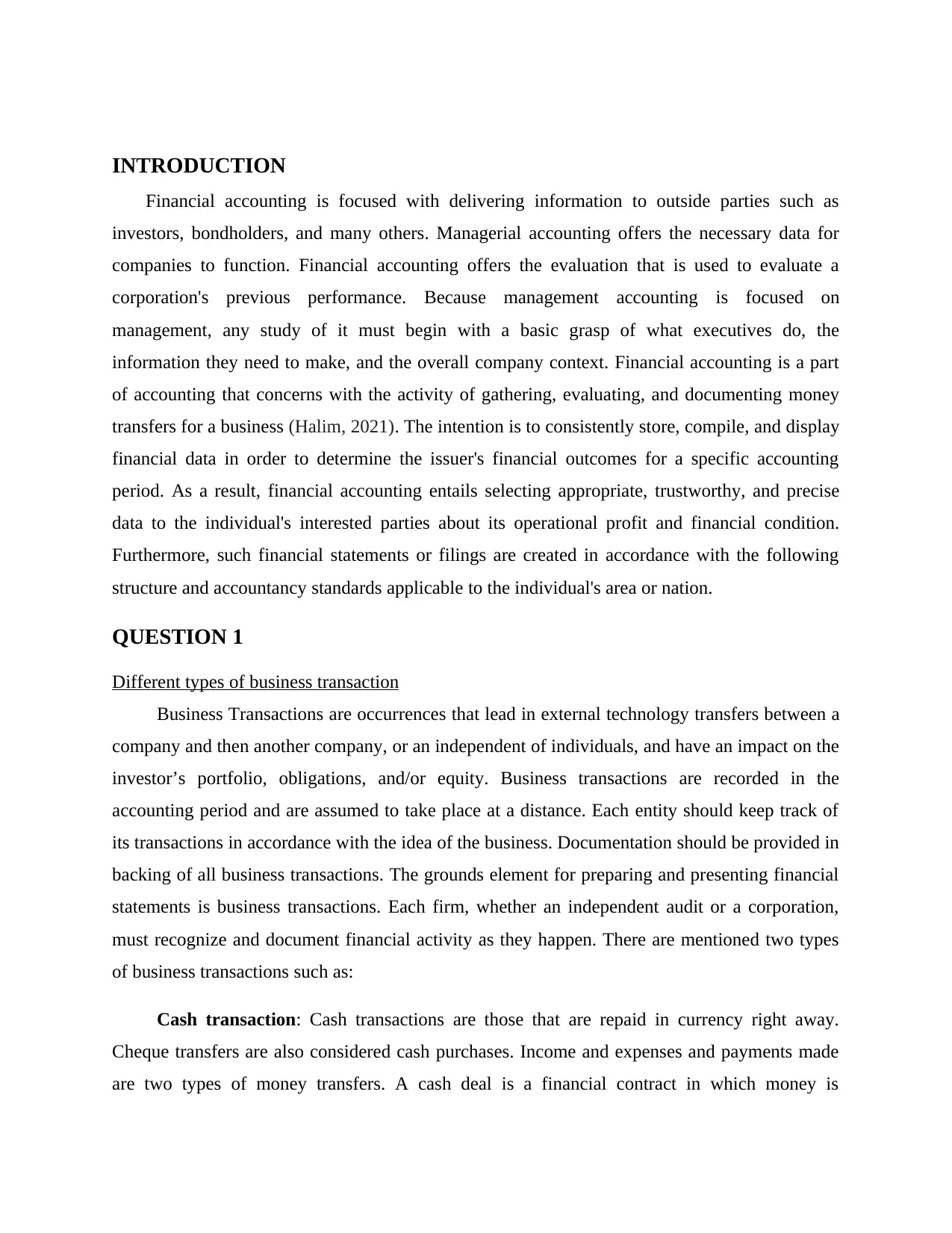
INTRODUCTION
Financial accounting is focused with delivering information to outside parties such as
investors, bondholders, and many others. Managerial accounting offers the necessary data for
companies to function. Financial accounting offers the evaluation that is used to evaluate a
corporation's previous performance. Because management accounting is focused on
management, any study of it must begin with a basic grasp of what executives do, the
information they need to make, and the overall company context. Financial accounting is a part
of accounting that concerns with the activity of gathering, evaluating, and documenting money
transfers for a business (Halim, 2021). The intention is to consistently store, compile, and display
financial data in order to determine the issuer's financial outcomes for a specific accounting
period. As a result, financial accounting entails selecting appropriate, trustworthy, and precise
data to the individual's interested parties about its operational profit and financial condition.
Furthermore, such financial statements or filings are created in accordance with the following
structure and accountancy standards applicable to the individual's area or nation.
QUESTION 1
Different types of business transaction
Business Transactions are occurrences that lead in external technology transfers between a
company and then another company, or an independent of individuals, and have an impact on the
investor’s portfolio, obligations, and/or equity. Business transactions are recorded in the
accounting period and are assumed to take place at a distance. Each entity should keep track of
its transactions in accordance with the idea of the business. Documentation should be provided in
backing of all business transactions. The grounds element for preparing and presenting financial
statements is business transactions. Each firm, whether an independent audit or a corporation,
must recognize and document financial activity as they happen. There are mentioned two types
of business transactions such as:
Cash transaction: Cash transactions are those that are repaid in currency right away.
Cheque transfers are also considered cash purchases. Income and expenses and payments made
are two types of money transfers. A cash deal is a financial contract in which money is
Financial accounting is focused with delivering information to outside parties such as
investors, bondholders, and many others. Managerial accounting offers the necessary data for
companies to function. Financial accounting offers the evaluation that is used to evaluate a
corporation's previous performance. Because management accounting is focused on
management, any study of it must begin with a basic grasp of what executives do, the
information they need to make, and the overall company context. Financial accounting is a part
of accounting that concerns with the activity of gathering, evaluating, and documenting money
transfers for a business (Halim, 2021). The intention is to consistently store, compile, and display
financial data in order to determine the issuer's financial outcomes for a specific accounting
period. As a result, financial accounting entails selecting appropriate, trustworthy, and precise
data to the individual's interested parties about its operational profit and financial condition.
Furthermore, such financial statements or filings are created in accordance with the following
structure and accountancy standards applicable to the individual's area or nation.
QUESTION 1
Different types of business transaction
Business Transactions are occurrences that lead in external technology transfers between a
company and then another company, or an independent of individuals, and have an impact on the
investor’s portfolio, obligations, and/or equity. Business transactions are recorded in the
accounting period and are assumed to take place at a distance. Each entity should keep track of
its transactions in accordance with the idea of the business. Documentation should be provided in
backing of all business transactions. The grounds element for preparing and presenting financial
statements is business transactions. Each firm, whether an independent audit or a corporation,
must recognize and document financial activity as they happen. There are mentioned two types
of business transactions such as:
Cash transaction: Cash transactions are those that are repaid in currency right away.
Cheque transfers are also considered cash purchases. Income and expenses and payments made
are two types of money transfers. A cash deal is a financial contract in which money is
Paraphrase This Document
Need a fresh take? Get an instant paraphrase of this document with our AI Paraphraser
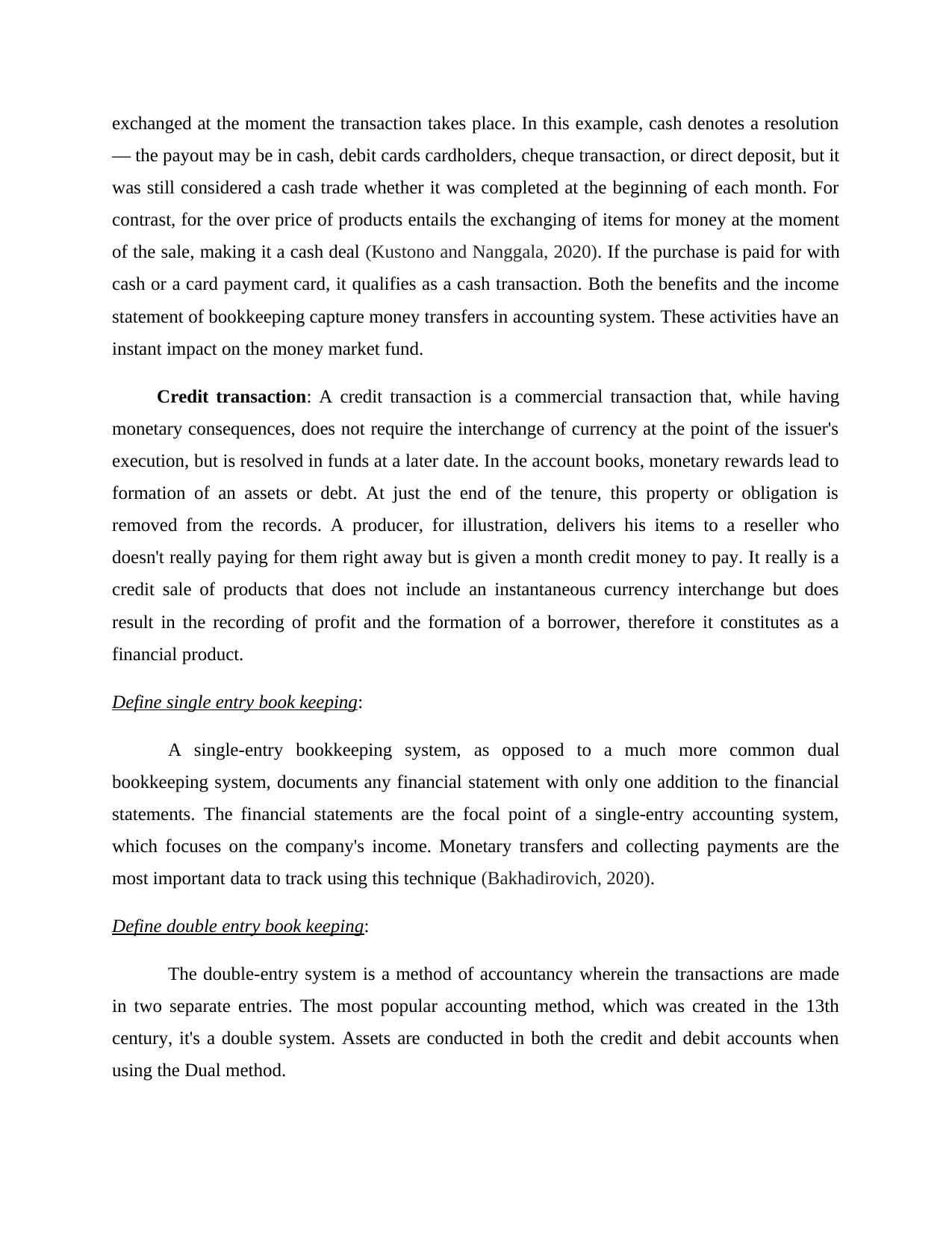
exchanged at the moment the transaction takes place. In this example, cash denotes a resolution
— the payout may be in cash, debit cards cardholders, cheque transaction, or direct deposit, but it
was still considered a cash trade whether it was completed at the beginning of each month. For
contrast, for the over price of products entails the exchanging of items for money at the moment
of the sale, making it a cash deal (Kustono and Nanggala, 2020). If the purchase is paid for with
cash or a card payment card, it qualifies as a cash transaction. Both the benefits and the income
statement of bookkeeping capture money transfers in accounting system. These activities have an
instant impact on the money market fund.
Credit transaction: A credit transaction is a commercial transaction that, while having
monetary consequences, does not require the interchange of currency at the point of the issuer's
execution, but is resolved in funds at a later date. In the account books, monetary rewards lead to
formation of an assets or debt. At just the end of the tenure, this property or obligation is
removed from the records. A producer, for illustration, delivers his items to a reseller who
doesn't really paying for them right away but is given a month credit money to pay. It really is a
credit sale of products that does not include an instantaneous currency interchange but does
result in the recording of profit and the formation of a borrower, therefore it constitutes as a
financial product.
Define single entry book keeping:
A single-entry bookkeeping system, as opposed to a much more common dual
bookkeeping system, documents any financial statement with only one addition to the financial
statements. The financial statements are the focal point of a single-entry accounting system,
which focuses on the company's income. Monetary transfers and collecting payments are the
most important data to track using this technique (Bakhadirovich, 2020).
Define double entry book keeping:
The double-entry system is a method of accountancy wherein the transactions are made
in two separate entries. The most popular accounting method, which was created in the 13th
century, it's a double system. Assets are conducted in both the credit and debit accounts when
using the Dual method.
— the payout may be in cash, debit cards cardholders, cheque transaction, or direct deposit, but it
was still considered a cash trade whether it was completed at the beginning of each month. For
contrast, for the over price of products entails the exchanging of items for money at the moment
of the sale, making it a cash deal (Kustono and Nanggala, 2020). If the purchase is paid for with
cash or a card payment card, it qualifies as a cash transaction. Both the benefits and the income
statement of bookkeeping capture money transfers in accounting system. These activities have an
instant impact on the money market fund.
Credit transaction: A credit transaction is a commercial transaction that, while having
monetary consequences, does not require the interchange of currency at the point of the issuer's
execution, but is resolved in funds at a later date. In the account books, monetary rewards lead to
formation of an assets or debt. At just the end of the tenure, this property or obligation is
removed from the records. A producer, for illustration, delivers his items to a reseller who
doesn't really paying for them right away but is given a month credit money to pay. It really is a
credit sale of products that does not include an instantaneous currency interchange but does
result in the recording of profit and the formation of a borrower, therefore it constitutes as a
financial product.
Define single entry book keeping:
A single-entry bookkeeping system, as opposed to a much more common dual
bookkeeping system, documents any financial statement with only one addition to the financial
statements. The financial statements are the focal point of a single-entry accounting system,
which focuses on the company's income. Monetary transfers and collecting payments are the
most important data to track using this technique (Bakhadirovich, 2020).
Define double entry book keeping:
The double-entry system is a method of accountancy wherein the transactions are made
in two separate entries. The most popular accounting method, which was created in the 13th
century, it's a double system. Assets are conducted in both the credit and debit accounts when
using the Dual method.
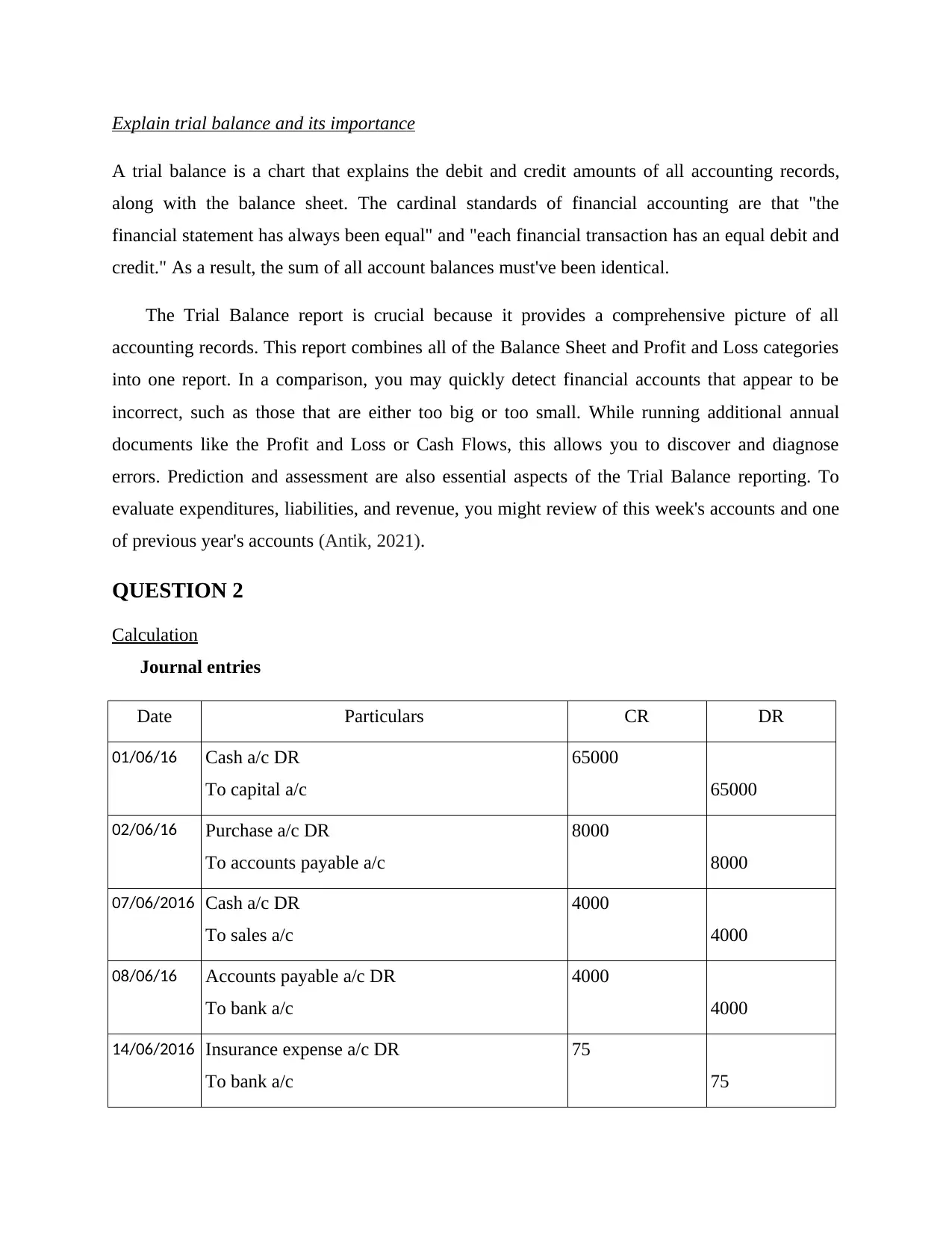
Explain trial balance and its importance
A trial balance is a chart that explains the debit and credit amounts of all accounting records,
along with the balance sheet. The cardinal standards of financial accounting are that "the
financial statement has always been equal" and "each financial transaction has an equal debit and
credit." As a result, the sum of all account balances must've been identical.
The Trial Balance report is crucial because it provides a comprehensive picture of all
accounting records. This report combines all of the Balance Sheet and Profit and Loss categories
into one report. In a comparison, you may quickly detect financial accounts that appear to be
incorrect, such as those that are either too big or too small. While running additional annual
documents like the Profit and Loss or Cash Flows, this allows you to discover and diagnose
errors. Prediction and assessment are also essential aspects of the Trial Balance reporting. To
evaluate expenditures, liabilities, and revenue, you might review of this week's accounts and one
of previous year's accounts (Antik, 2021).
QUESTION 2
Calculation
Journal entries
Date Particulars CR DR
01/06/16 Cash a/c DR
To capital a/c
65000
65000
02/06/16 Purchase a/c DR
To accounts payable a/c
8000
8000
07/06/2016 Cash a/c DR
To sales a/c
4000
4000
08/06/16 Accounts payable a/c DR
To bank a/c
4000
4000
14/06/2016 Insurance expense a/c DR
To bank a/c
75
75
A trial balance is a chart that explains the debit and credit amounts of all accounting records,
along with the balance sheet. The cardinal standards of financial accounting are that "the
financial statement has always been equal" and "each financial transaction has an equal debit and
credit." As a result, the sum of all account balances must've been identical.
The Trial Balance report is crucial because it provides a comprehensive picture of all
accounting records. This report combines all of the Balance Sheet and Profit and Loss categories
into one report. In a comparison, you may quickly detect financial accounts that appear to be
incorrect, such as those that are either too big or too small. While running additional annual
documents like the Profit and Loss or Cash Flows, this allows you to discover and diagnose
errors. Prediction and assessment are also essential aspects of the Trial Balance reporting. To
evaluate expenditures, liabilities, and revenue, you might review of this week's accounts and one
of previous year's accounts (Antik, 2021).
QUESTION 2
Calculation
Journal entries
Date Particulars CR DR
01/06/16 Cash a/c DR
To capital a/c
65000
65000
02/06/16 Purchase a/c DR
To accounts payable a/c
8000
8000
07/06/2016 Cash a/c DR
To sales a/c
4000
4000
08/06/16 Accounts payable a/c DR
To bank a/c
4000
4000
14/06/2016 Insurance expense a/c DR
To bank a/c
75
75
⊘ This is a preview!⊘
Do you want full access?
Subscribe today to unlock all pages.

Trusted by 1+ million students worldwide
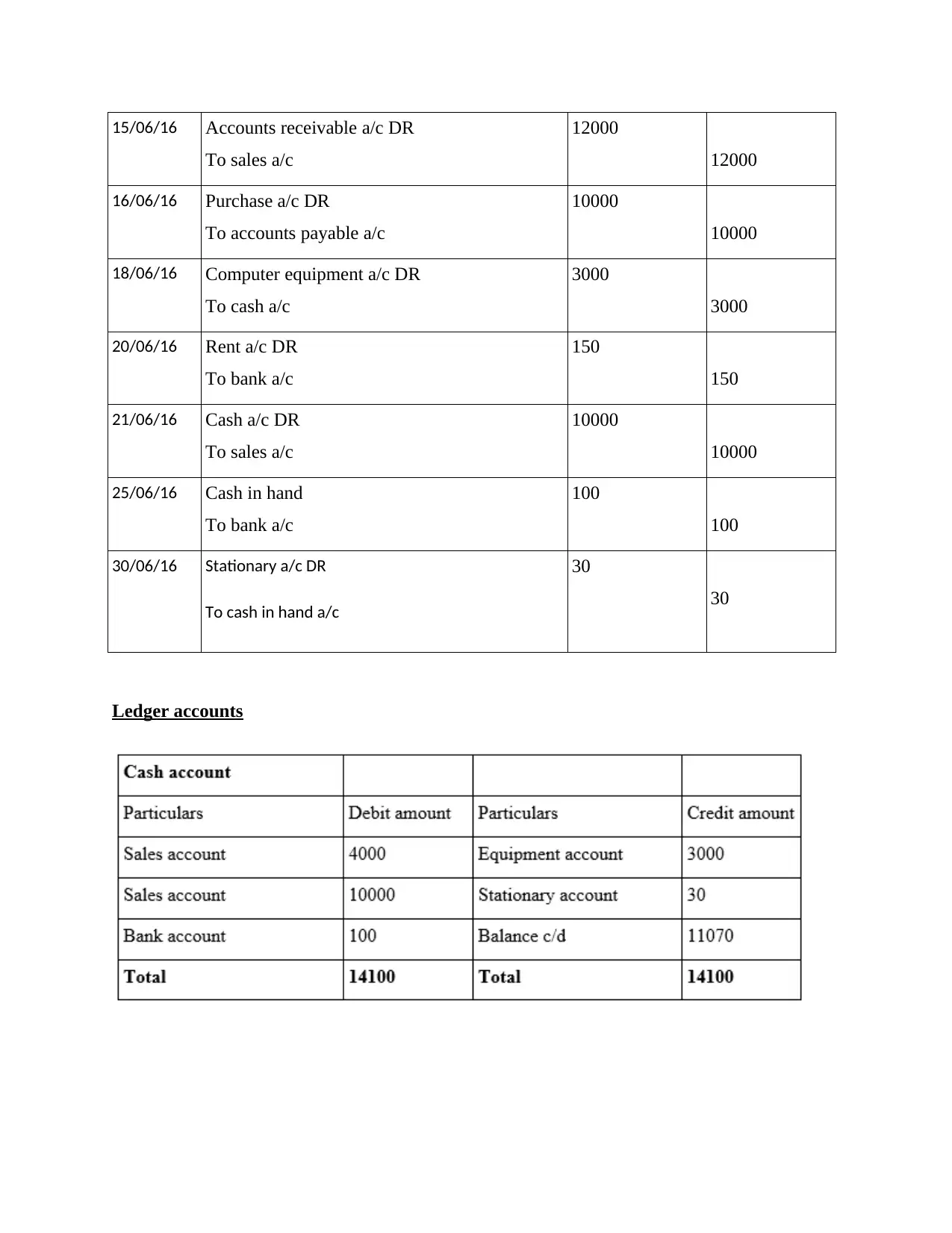
15/06/16 Accounts receivable a/c DR
To sales a/c
12000
12000
16/06/16 Purchase a/c DR
To accounts payable a/c
10000
10000
18/06/16 Computer equipment a/c DR
To cash a/c
3000
3000
20/06/16 Rent a/c DR
To bank a/c
150
150
21/06/16 Cash a/c DR
To sales a/c
10000
10000
25/06/16 Cash in hand
To bank a/c
100
100
30/06/16 Stationary a/c DR
To cash in hand a/c
30
30
Ledger accounts
To sales a/c
12000
12000
16/06/16 Purchase a/c DR
To accounts payable a/c
10000
10000
18/06/16 Computer equipment a/c DR
To cash a/c
3000
3000
20/06/16 Rent a/c DR
To bank a/c
150
150
21/06/16 Cash a/c DR
To sales a/c
10000
10000
25/06/16 Cash in hand
To bank a/c
100
100
30/06/16 Stationary a/c DR
To cash in hand a/c
30
30
Ledger accounts
Paraphrase This Document
Need a fresh take? Get an instant paraphrase of this document with our AI Paraphraser
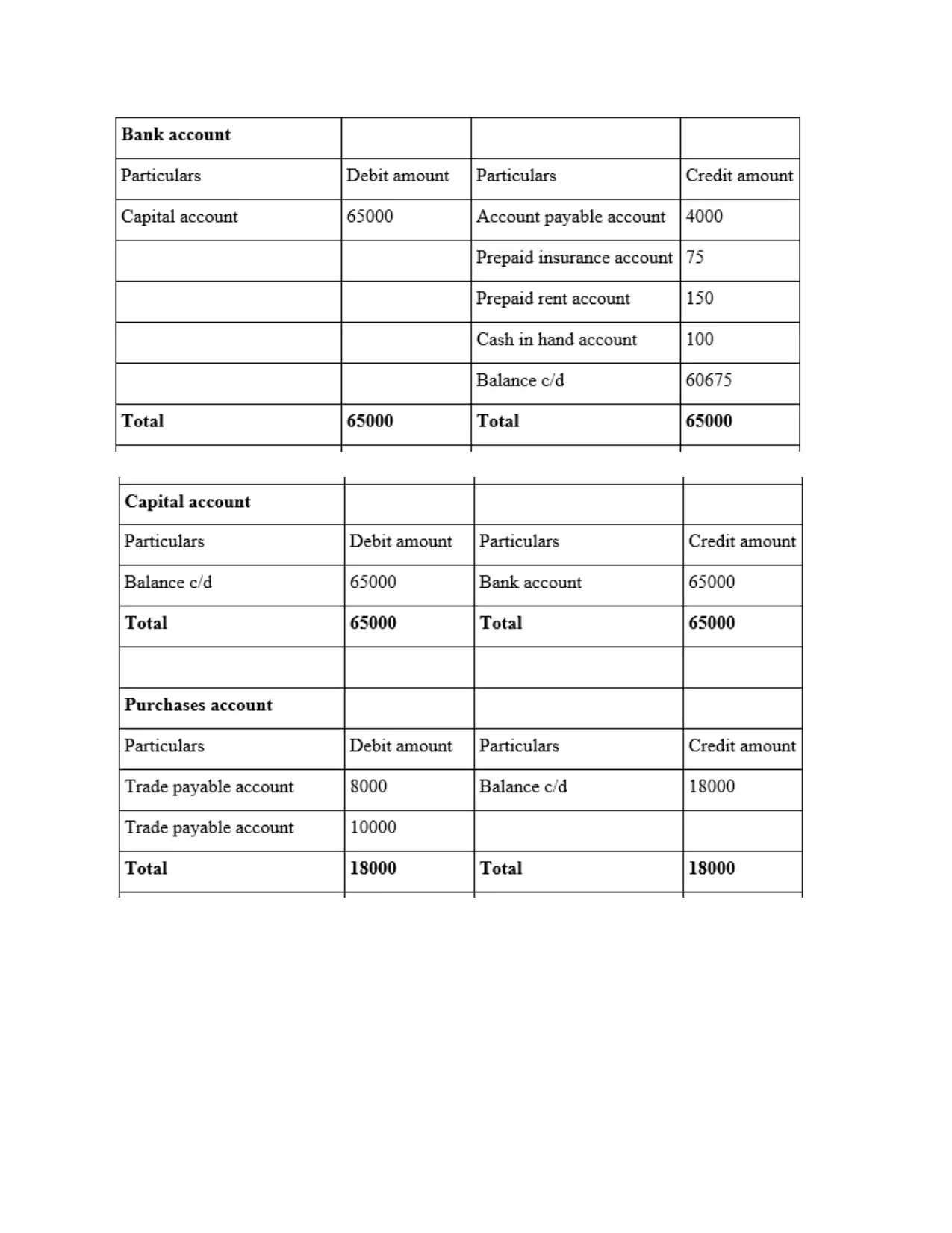
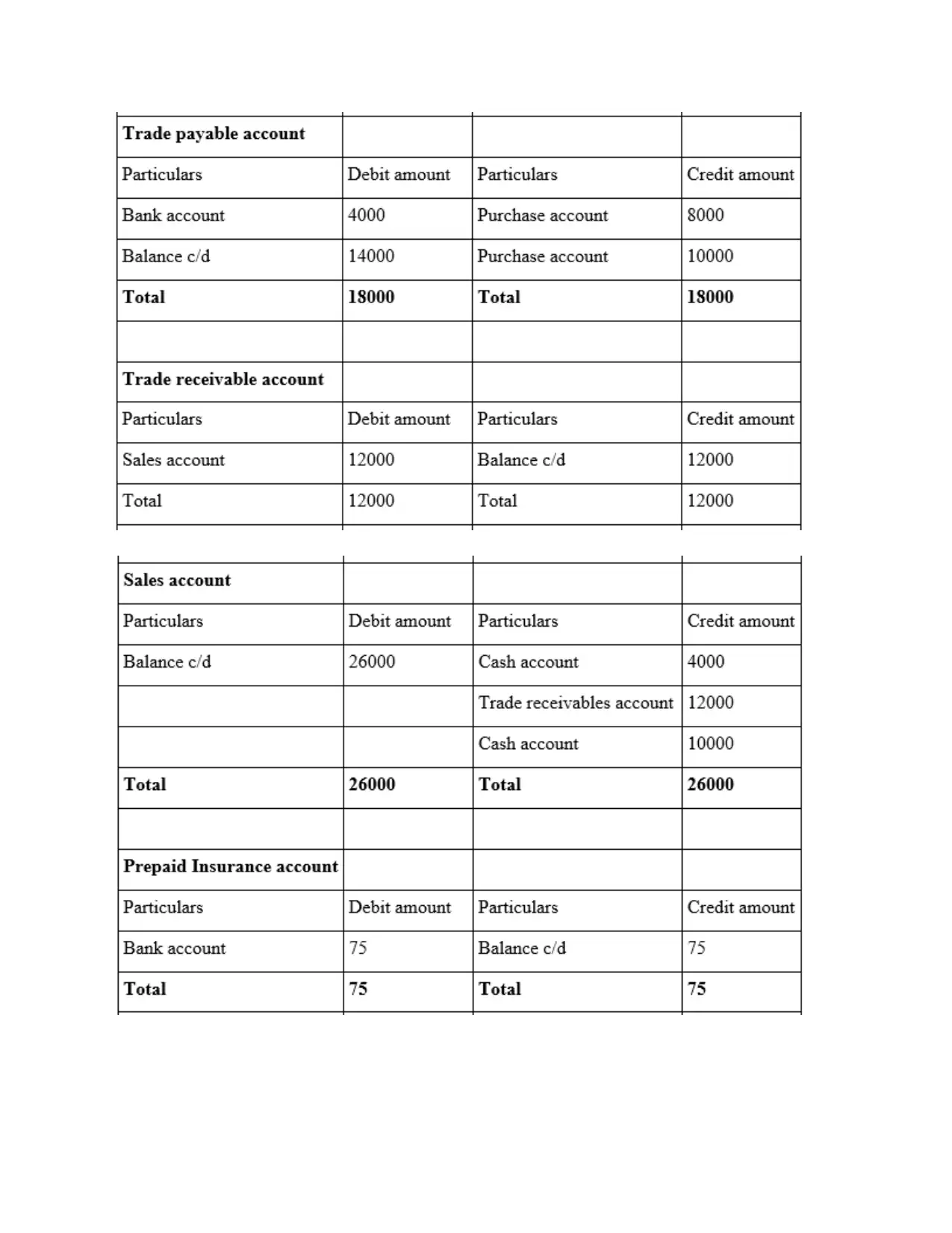
⊘ This is a preview!⊘
Do you want full access?
Subscribe today to unlock all pages.

Trusted by 1+ million students worldwide
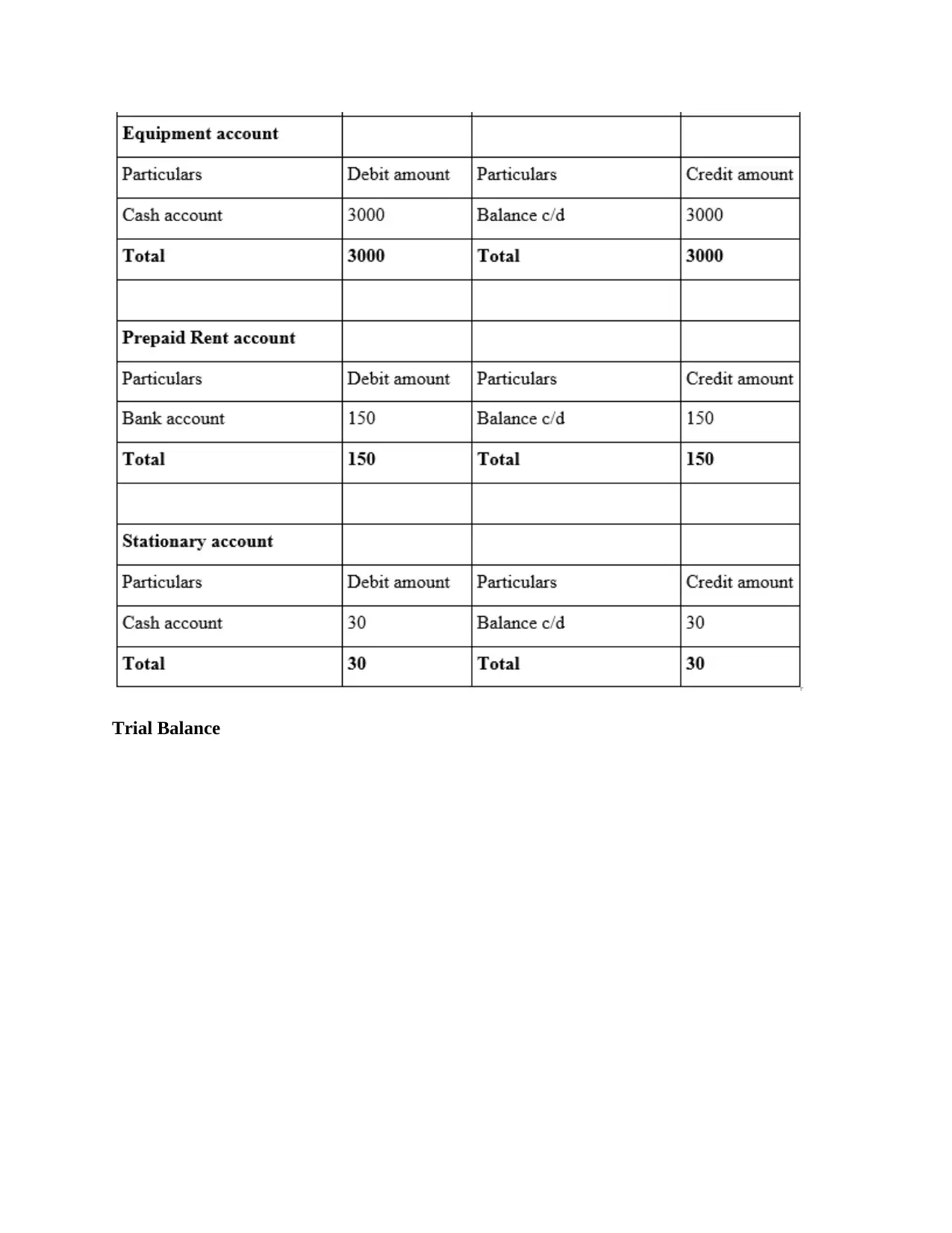
Trial Balance
Paraphrase This Document
Need a fresh take? Get an instant paraphrase of this document with our AI Paraphraser
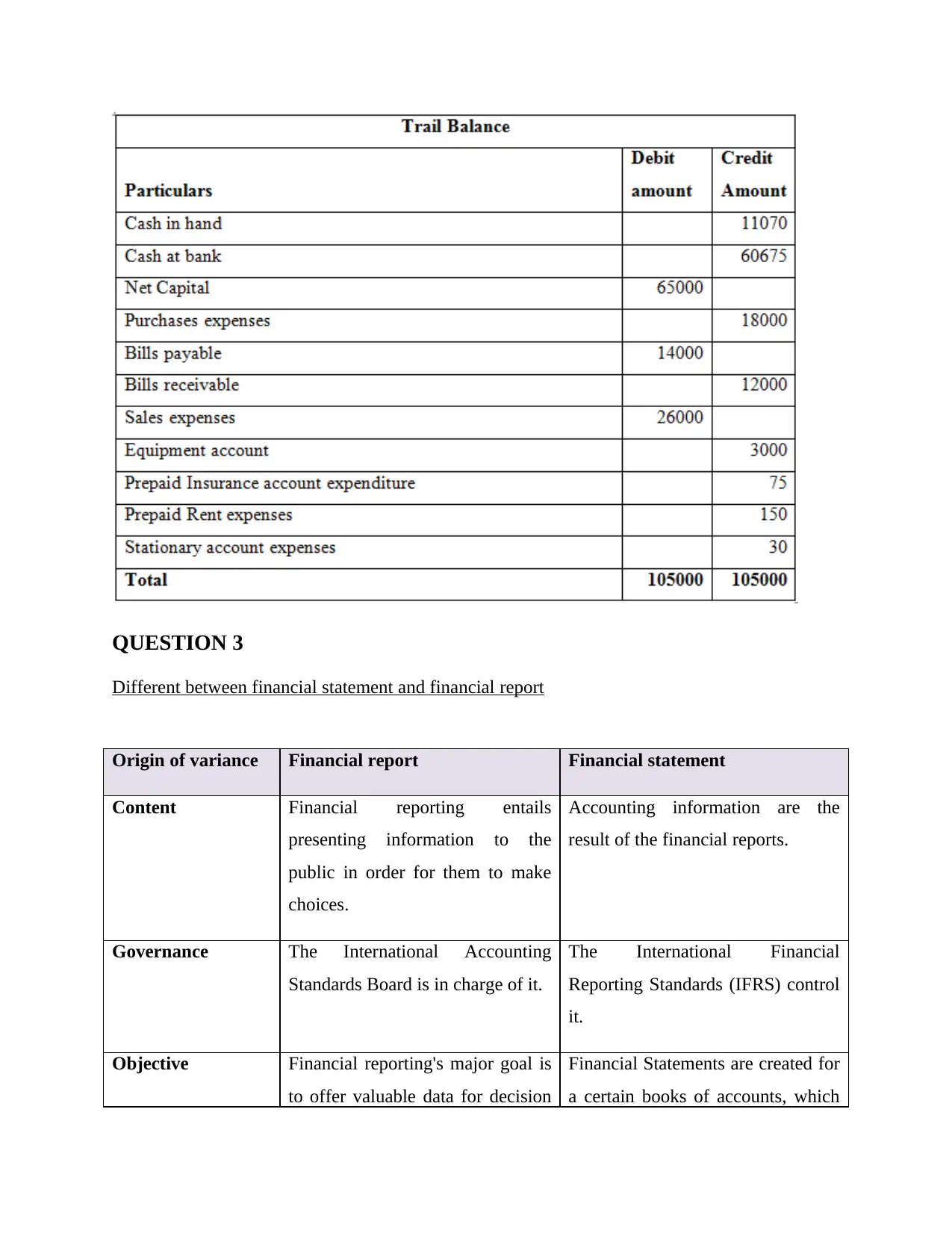
QUESTION 3
Different between financial statement and financial report
Origin of variance Financial report Financial statement
Content Financial reporting entails
presenting information to the
public in order for them to make
choices.
Accounting information are the
result of the financial reports.
Governance The International Accounting
Standards Board is in charge of it.
The International Financial
Reporting Standards (IFRS) control
it.
Objective Financial reporting's major goal is
to offer valuable data for decision
Financial Statements are created for
a certain books of accounts, which
Different between financial statement and financial report
Origin of variance Financial report Financial statement
Content Financial reporting entails
presenting information to the
public in order for them to make
choices.
Accounting information are the
result of the financial reports.
Governance The International Accounting
Standards Board is in charge of it.
The International Financial
Reporting Standards (IFRS) control
it.
Objective Financial reporting's major goal is
to offer valuable data for decision
Financial Statements are created for
a certain books of accounts, which
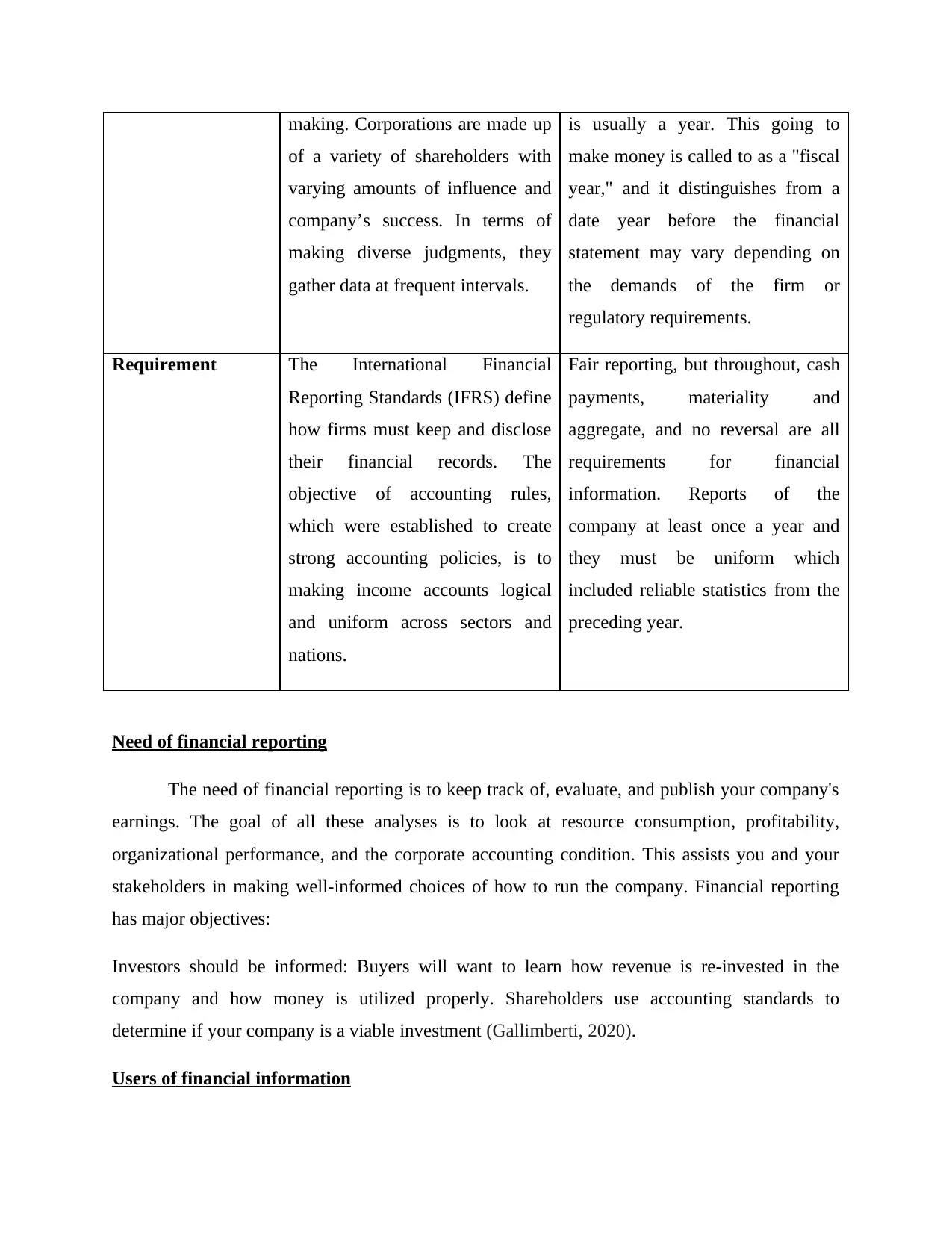
making. Corporations are made up
of a variety of shareholders with
varying amounts of influence and
company’s success. In terms of
making diverse judgments, they
gather data at frequent intervals.
is usually a year. This going to
make money is called to as a "fiscal
year," and it distinguishes from a
date year before the financial
statement may vary depending on
the demands of the firm or
regulatory requirements.
Requirement The International Financial
Reporting Standards (IFRS) define
how firms must keep and disclose
their financial records. The
objective of accounting rules,
which were established to create
strong accounting policies, is to
making income accounts logical
and uniform across sectors and
nations.
Fair reporting, but throughout, cash
payments, materiality and
aggregate, and no reversal are all
requirements for financial
information. Reports of the
company at least once a year and
they must be uniform which
included reliable statistics from the
preceding year.
Need of financial reporting
The need of financial reporting is to keep track of, evaluate, and publish your company's
earnings. The goal of all these analyses is to look at resource consumption, profitability,
organizational performance, and the corporate accounting condition. This assists you and your
stakeholders in making well-informed choices of how to run the company. Financial reporting
has major objectives:
Investors should be informed: Buyers will want to learn how revenue is re-invested in the
company and how money is utilized properly. Shareholders use accounting standards to
determine if your company is a viable investment (Gallimberti, 2020).
Users of financial information
of a variety of shareholders with
varying amounts of influence and
company’s success. In terms of
making diverse judgments, they
gather data at frequent intervals.
is usually a year. This going to
make money is called to as a "fiscal
year," and it distinguishes from a
date year before the financial
statement may vary depending on
the demands of the firm or
regulatory requirements.
Requirement The International Financial
Reporting Standards (IFRS) define
how firms must keep and disclose
their financial records. The
objective of accounting rules,
which were established to create
strong accounting policies, is to
making income accounts logical
and uniform across sectors and
nations.
Fair reporting, but throughout, cash
payments, materiality and
aggregate, and no reversal are all
requirements for financial
information. Reports of the
company at least once a year and
they must be uniform which
included reliable statistics from the
preceding year.
Need of financial reporting
The need of financial reporting is to keep track of, evaluate, and publish your company's
earnings. The goal of all these analyses is to look at resource consumption, profitability,
organizational performance, and the corporate accounting condition. This assists you and your
stakeholders in making well-informed choices of how to run the company. Financial reporting
has major objectives:
Investors should be informed: Buyers will want to learn how revenue is re-invested in the
company and how money is utilized properly. Shareholders use accounting standards to
determine if your company is a viable investment (Gallimberti, 2020).
Users of financial information
⊘ This is a preview!⊘
Do you want full access?
Subscribe today to unlock all pages.

Trusted by 1+ million students worldwide
1 out of 27
Related Documents
Your All-in-One AI-Powered Toolkit for Academic Success.
+13062052269
info@desklib.com
Available 24*7 on WhatsApp / Email
![[object Object]](/_next/static/media/star-bottom.7253800d.svg)
Unlock your academic potential
Copyright © 2020–2025 A2Z Services. All Rights Reserved. Developed and managed by ZUCOL.





